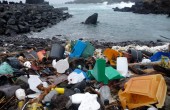Featured Stories | December 29, 2014
Best of Oceans at MIT 2014
By Genevieve Wanucha
As the New Year begins, Oceans at MIT is gearing up for a whole new batch of stories that explore the ocean-related research and engineering at MIT and WHOI. It’s the perfect time to take a look back at Oceans at MIT’s past twelve months. We have a diverse batch of articles, including an interview that gives the most complete perspective on the troubled future of Arctic environmental policy, a look at the issue of marine plastic pollution, two stories that deepen our basic understanding of the ocean’s role in global warming, a celebration of women in marine science, coverage of the NYC Climate Change March, an exploration of how new private funding will transform microbial oceanography, MIT urban architects’ plan to save New Jersey’s coasts, and more! With out further ado, here is a list of the top 15 most popular stories of the past year.
Stay tuned in 2015 because a great new science writer is joining Oceans at MIT, and remember to follow Oceans at MIT on Facebook and on Twitter at MIT_Oceans. For stories devoted to research from the MIT Program on Atmospheres, Oceans, and Climate in EAPS, see this list of Spotlights.

Climate Feedback: Improving Media Coverage of Climate Science MIT’s Emmanuel Vincent has launched Climate Feedback, a new web-based tool to improve the accuracy of climate science reporting in the media.

The cold hard truth about Arctic policy: Interview with Lawrence Susskind Oceans at MIT talks to environmental policy expert Lawrence Susskind about the unprecedented need for new Arctic agreements and how to achieve them.

A Quarter Million Tons of Plastic Float in Our Oceans, says Dr. Marcus Eriksen Oceans at MIT interviews a prominent marine plastic pollution scientist and activist about the newly published estimate of plastic bits in the world ocean, the scope of the environmental problem, possible solutions, and his science and art.

The Missing Piece of the Climate Puzzle MIT researchers find that a canonical view of global warming tells only half the story. They ultimately refine our understanding of the greenhouse gas effect.

Women in Marine Science Seize the Day The inaugural workshop of the Society for Women in Marine Science (SWMS) took place at Woods Hole Oceanographic Institution on September 26, 2014.

Where time stands still, ideas travel generations Tradition, chalkboard mathematics, “free-wheeling” lectures, mentorship, and ample time to think make the Geophysical Fluid Dynamics program a summer school like no other.

Flying on the Foils: a Q&A with Brooks Reed, MIT’s Moth Sailor All summer, a hydrofoiling sailboat has been flying atop the Charles River. The person skillfully handling this International Moth Class boat is none other than Brooks Reed, a professional sailor and MIT PhD student in MIT Mech E.

Broadening the ‘scope’ of microbial oceanography With an infusion of private funds, MIT researchers will break new ground in the study of marine microbes at the legendary ocean field site Station ALOHA.

Going Local in the Coral Triangle One MIT researcher is helping rural fishing communities improve the resilience of the fragile marine ecosystems they depend on for everything.

How the Ocean Reins in Global Warming In recent years, a hot topic in climate science has arisen over the fact that climate models vary widely in their representation of ocean heat uptake. The oceans in some models absorb more or less heat in high-latitude regions such as the North Atlantic and Southern Ocean; some store heat at different depths. According to two new papers published in Geophysical Research Letters, those details matter a great deal to the predictions of global warming over the coming centuries.

A Visit from the “Dragon” of Rapid Ice Sheet Collapse Polar ice expert Richard Alley delivered the 14th Annual Henry W. Kendall Memorial Lecture “Ice Sheets and Sea Level: Is the Long Tail Attached to a Dragon?,” delving into the process of ice sheet melting and the risks and uncertainties of climate change and sea level rise

A Brave New Ocean World The highest-ever resolution run of a 3-D global ocean model is a milestone application of the MIT General Circulation Model (MITgcm), developed here at MIT. Here’s a story about how this model will change the way researchers study everything from ocean circulation to the role of phytoplankton in the marine ecosystem.

MIT’s Plan to Save New Jersey from the Next Hurricane Wins the HUD Competition An MIT team has won the Rebuild by Design competition with their innovative plan to to protect New Jersey and Metropolitan New York coastlines from the next Hurricane Sandy.

Voices of MIT at the People’s Climate March 70 MIT students, researchers, and alumni took the opportunity to publicly demand action to combat the unchecked use of fossil fuels at the People’s Climate March in NYC.




